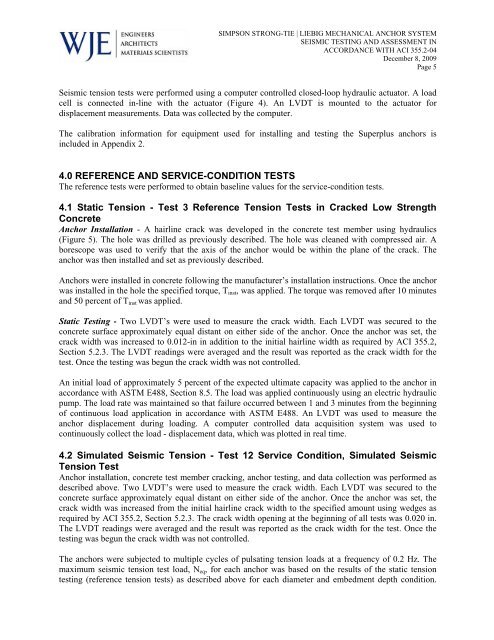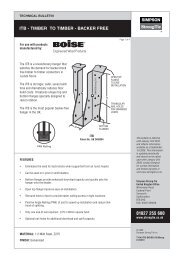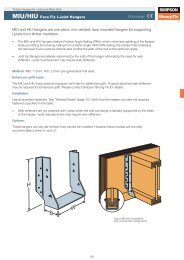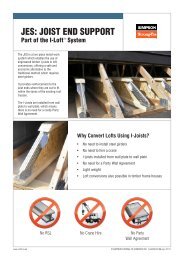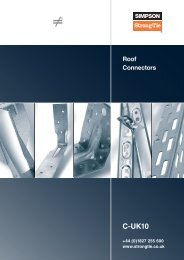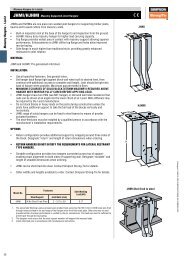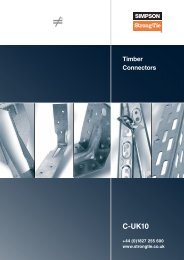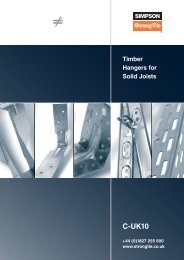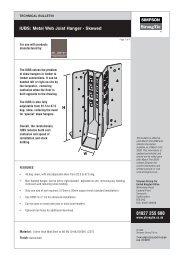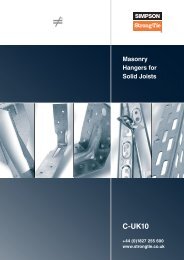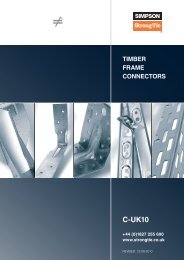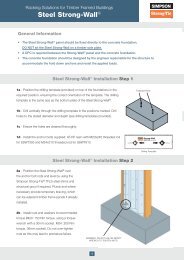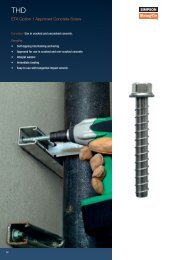simpson strong-tie | liebig mechanical anchor system seismic testing ...
simpson strong-tie | liebig mechanical anchor system seismic testing ...
simpson strong-tie | liebig mechanical anchor system seismic testing ...
You also want an ePaper? Increase the reach of your titles
YUMPU automatically turns print PDFs into web optimized ePapers that Google loves.
SIMPSON STRONG-TIE | LIEBIG MECHANICAL ANCHOR SYSTEMSEISMIC TESTING AND ASSESSMENT INACCORDANCE WITH ACI 355.2-04December 8, 2009Page 5Seismic tension tests were performed using a computer controlled closed-loop hydraulic actuator. A loadcell is connected in-line with the actuator (Figure 4). An LVDT is mounted to the actuator fordisplacement measurements. Data was collected by the computer.The calibration information for equipment used for installing and <strong>testing</strong> the Superplus <strong>anchor</strong>s isincluded in Appendix 2.4.0 REFERENCE AND SERVICE-CONDITION TESTSThe reference tests were performed to obtain baseline values for the service-condition tests.4.1 Static Tension - Test 3 Reference Tension Tests in Cracked Low StrengthConcreteAnchor Installation - A hairline crack was developed in the concrete test member using hydraulics(Figure 5). The hole was drilled as previously described. The hole was cleaned with compressed air. Aborescope was used to verify that the axis of the <strong>anchor</strong> would be within the plane of the crack. The<strong>anchor</strong> was then installed and set as previously described.Anchors were installed in concrete following the manuwas installed in the hole the specified torque, T inst , was applied. The torque was removed after 10 minutesand 50 percent of T inst was applied.Static Testingack width. Each LVDT was secured to theconcrete surface approximately equal distant on either side of the <strong>anchor</strong>. Once the <strong>anchor</strong> was set, thecrack width was increased to 0.012-in in addition to the initial hairline width as required by ACI 355.2,Section 5.2.3. The LVDT readings were averaged and the result was reported as the crack width for thetest. Once the <strong>testing</strong> was begun the crack width was not controlled.An initial load of approximately 5 percent of the expected ultimate capacity was applied to the <strong>anchor</strong> inaccordance with ASTM E488, Section 8.5. The load was applied continuously using an electric hydraulicpump. The load rate was maintained so that failure occurred between 1 and 3 minutes from the beginningof continuous load application in accordance with ASTM E488. An LVDT was used to measure the<strong>anchor</strong> displacement during loading. A computer controlled data acquisition <strong>system</strong> was used tocontinuously collect the load - displacement data, which was plotted in real time.4.2 Simulated Seismic Tension - Test 12 Service Condition, Simulated SeismicTension TestAnchor installation, concrete test member cracking, <strong>anchor</strong> <strong>testing</strong>, and data collection was performed asthe crack width. Each LVDT was secured to theconcrete surface approximately equal distant on either side of the <strong>anchor</strong>. Once the <strong>anchor</strong> was set, thecrack width was increased from the initial hairline crack width to the specified amount using wedges asrequired by ACI 355.2, Section 5.2.3. The crack width opening at the beginning of all tests was 0.020 in.The LVDT readings were averaged and the result was reported as the crack width for the test. Once the<strong>testing</strong> was begun the crack width was not controlled.The <strong>anchor</strong>s were subjected to multiple cycles of pulsating tension loads at a frequency of 0.2 Hz. Themaximum <strong>seismic</strong> tension test load, N eq , for each <strong>anchor</strong> was based on the results of the static tension<strong>testing</strong> (reference tension tests) as described above for each diameter and embedment depth condition.


